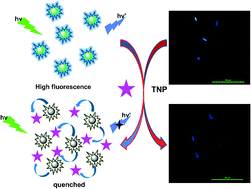P-doped carbon dots act as a nanosensor for trace 2,4,6-trinitrophenol detection and a fluorescent reagent for biological imaging†
Abstract
A simple and rapid method for sensitive and selective detection of 2,4,6-trinitrophenol (TNP) was developed with the use of water-soluble carbon dots (CDs) as a nanosensor. The CDs with a fluorescence quantum yield of 21.8% are easily prepared by hydrothermal treatment of a sucrose phosphate solution. In this sensing system, the fluorescence of CDs would be significantly quenched by TNP, while other nitroaromatic derivatives and common reagents exhibited little influence on the detection of TNP. The efficient selective detection of TNP can be attributed to the fluorescence resonance energy transfer process (FRET). This phenomenon can be used for the selective sensing of TNP with a limit of detection of 16.9 nM and a linear range of 0.2–17.0 μM. The recovery result for TNP in real samples by this assay method was satisfying, demonstrating its potential application as a fluorescence sensor. Furthermore, the resulting CDs solution could replace traditional colorings and was successfully applied for Escherichia coli labeling and intracellular imaging.


 Please wait while we load your content...
Please wait while we load your content...